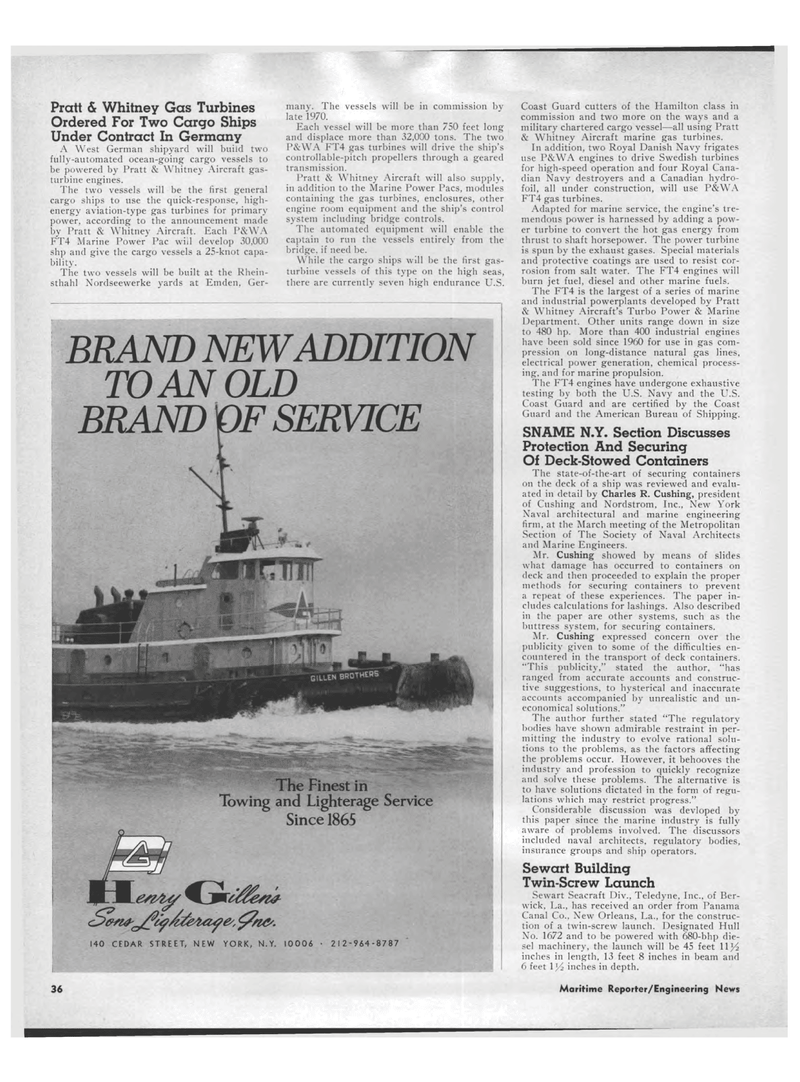
Page 34: of Maritime Reporter Magazine (April 15, 1969)
Read this page in Pdf, Flash or Html5 edition of April 15, 1969 Maritime Reporter Magazine
Pratt & Whitney Gas Turbines Ordered For Two Cargo Ships Under Contract In Germany A West German shipyard will build two fully-automated ocean-going cargo vessels to be powered by Pratt & Whitney Aircraft gas-turbine engines. The two vessels will be the first general cargo ships to use the quick-response, high-energy aviation-type gas turbines for primary power, according to the announcement made by Pratt & Whitney Aircraft. Each P&WA FT4 Marine Power Pac will develop 30,000 shp and give the cargo vessels a 25-knot capa-bility. The two vessels will be built at the Rhein-sthahl Nordseewerke yards at Emden, Ger-many. The vessels will be in commission by late 1970. Each vessel will be more than 750 feet long and displace more than 32,000 tons. The two P&WA FT4 gas turbines will drive the ship's controllable-pitch propellers through a geared transmission. Pratt & Whitney Aircraft will also supply, in addition to the Marine Power Pacs, modules containing the gas turbines, enclosures, other engine room equipment and the ship's control system including bridge controls. The automated equipment will enable the captain to run the vessels entirely from the bridge, if need be. While the cargo ships will be the first gas-turbine vessels of this type on the high seas, there are currently seven high endurance U.S. Coast Guard cutters of the Hamilton class in commission and two more on the ways and a military chartered cargo vessel?all using Pratt & Whitney Aircraft marine gas turbines. In addition, two Royal Danish Navy frigates use P&WA engines to drive Swedish turbines for high-speed operation and four Royal Cana-dian Navy destroyers and a Canadian hydro-foil, all under construction, will use P&WA FT4 gas turbines. Adapted for marine service, the engine's tre-mendous power is harnessed by adding a pow-er turbine to convert the hot gas energy from thrust to shaft horsepower. The power turbine is spun by the exhaust gases. Special materials and protective coatings are used to resist cor-rosion from salt water. The FT4 engines will burn jet fuel, diesel and other marine fuels. The FT4 is the largest of a series of marine and industrial powerplants developed by Pratt & Whitney Aircraft's Turbo Power & Marine Department. Other units range down in size to 480 hp. More than 400 industrial engines have been sold since 1960 for use in gas com-pression on long-distance natural gas lines, electrical power generation, chemical process-ing, and for marine propulsion. The FT4 engines have undergone exhaustive testing by both the U.S. Navy and the U.S. Coast Guard and are certified by the Coast Guard and the American Bureau of Shipping. SNAME N.Y. Section Discusses Protection And Securing Of Deck-Stowed Containers The state-of-the-art of securing containers on the deck of a ship was reviewed and evalu-ated in detail by Charles R. Cushing, president of Cushing and Nordstrom, Inc., New York Naval architectural and marine engineering firm, at the March meeting of the Metropolitan Section of The Society of Naval Architects and Marine Engineers. Mr. Cushing showed by means of slides what damage has occurred to containers on deck and then proceeded to explain the proper methods for securing containers to prevent a repeat of these experiences. The paper in-cludes calculations for lashings. Also described in the paper are other systems, such as the buttress system, for securing containers. Mr. Cushing expressed concern over the publicity given to some of the difficulties en-countered in the transport of deck containers. "This publicity," stated the author, "has ranged from accurate accounts and construc-tive suggestions, to hysterical and inaccurate accounts accompanied by unrealistic and un-economical solutions." The author further stated "The regulatory bodies have shown admirable restraint in per-mitting the industry to evolve rational solu-tions to the problems, as the factors affecting the problems occur. However, it behooves the industry and profession to quickly recognize and solve these problems. The alternative is to have solutions dictated in the form of regu-lations which may restrict progress." Considerable discussion was devloped by this paper since the marine industry is fully aware of problems involved. The discussors included naval architects, regulatory bodies, insurance groups and ship operators. Sewart Building Twin-Screw Launch Sewart Seacraft Div., Teledyne, Inc., of Ber-wick, La., has received an order from Panama Canal Co., New Orleans, La., for the construc-tion of a twin-screw launch. Designated Hull No. 1672 and to be powered with 680-bhp die-sel machinery, the launch will be 45 feet 11% inches in length, 13 feet 8 inches in beam and 6 feet 1Y2 inches in depth. BRAND NEW ADDITION TO AN OLD BRAND \OF SERVICE Towing and Lighterage Service Since 1865 140 CEDAR STREET, NEW YORK, N.Y. 10006 ? 212-964-8787 36 Maritime Reporter/Engineering News

 33
33

 35
35
